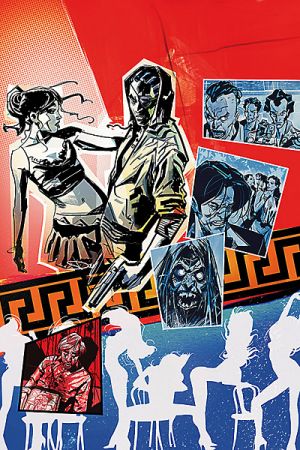Greek Street #16 (The End)
By Andy Frisk
October 21, 2010 - 23:50
DC Comics
Writer(s): Peter Milligan
Penciller(s): Davide Gianfelice
Inker(s): Davide Gianfelice
Colourist(s): Patricia Mulvihill
Letterer(s): Clem Robins
Cover Artist(s): David Furno
$2.99 US
“…maybe you should try reading through some passages of the Medea again. It might put you in the right mood.”
-Detective Dedalus
“God, spare me that ending. I mean, come on! Escaping on a winged chariot?”
-Sandy
Euripides’ Medea escaped on a winged chariot after killing her children. Milligan’s Medea escapes in the arms of love herself: Aphrodite. Thankfully, we aren’t spared this fitting, yet way too early, ending to Peter Milligan’s reimagining of the ancient Greek stories as told by Euripides, Aeschylus, and other ancient playwrights. It was an intelligent undertaking that didn’t require one to be familiar with the ancient stories to appreciate, but was that rarest of tales that actually inspired one to pick them up and, if not read them through, at least learn about them. For this fact alone, Greek Street was an endeavor of the most important kind in the world of sequential art literature as it helped to keep alive and stir interest in some of the most powerful and universal (to the human experience) tales that were ever written and acted. Sadly, it appears that too few mainstream comic book fans were even familiar enough with the ancient Greek plays to appreciate Milligan’s attempt to breathe new pop cultural life into them. Too often if something is written by someone whose name us moderns have a hard time pronouncing, we simply write it off and move on to the next episode of True Blood or (God forbid) The Twilight Saga. While there might be some interesting and, at times, poignant themes in these aforementioned excursions into fantasy worlds, (and I only name these two examples because they are the most popular stories that popped into my mind—my subconscious must be trying to tell me something….), the fantasy worlds of the ancient Greek plays (along with the epically poetic Heaven, Hell, and Paradise of John Milton’s and the great stories of Shakespeare’s) are much more engaging and worth the effort of ingesting. I say ingesting because one cannot simply read these works, but must take them into oneself and allow them to become a part of oneself. Only by doing so can the reader gain access to the enlightenment that these stories are filled with. After reading through every issue of Milligan’s Greek Street, it becomes very obvious to the careful and interested reader that Milligan himself very carefully ingested every theme and relevant idea of the ancient Greeks’ stories and did something that only an artist can do: reinvent and reinvigorate the ideas themselves while re-presenting them in an exciting and groundbreaking new way to a new audience.
 |
To borrow a line from one of the aforementioned playwrights, “all’s well that ends well” as far as most of the unresolved loose ends go in Milligan’s final episode of the series. Several of these plot lines are tied up, albeit a bit hastily, while others are left tantalizingly loose. The old stories certainly weren’t “done with us,” as Chantal the stripper and series chorus once stated, and they most likely still aren’t. We just won’t be seeing them from Milligan’s crime underworld setting’s perspective anymore. Our heroes Eddie (Oedipus) and Mischa (Medea) meet a fitting end. While that sounds ominous, it isn’t meant to be. Finally, both might have found a supernatural peace that they couldn’t find in the natural world of men. The series ending takes its cue from the final scenes of Medea, but holding true to Milligan’s style and thematic direction, Greek Street’s ending is a reflection and reimagining of Medea’s flight, not a simple recapitulation of it.
Artist Davide Gianfelice managed to continue to bring to life Milligan’s vision of a London crime underground’s drama that reflected and drew inspiration from the ancient stories right up to the end. His dramatic facial expressions and well choreographed scenes, mixed with some pretty horrific supernatural images, managed to capture all of the drama fitting a visualization of Milligan’s world of chorus girls, bloodthirsty monsters, posh gangsters, and dedicated policemen and women. Gianfelice has demonstrated, quite admirably, that he can effectively bring to life everything from a raving nude monster of a corpse to London police to posh gangsters with all of the realism of detail that each subject requires to make the mundane and fantastic believable. (Oh, and he wasn’t too bad at bringing some Vikings to life over in the early issues of Brian Wood’s also brilliant Northlanders series, by the way.)
While Greek Street itself may be history now, there is still plenty to talk about as pertains to this series. Sequential art scholars and simple fans (like myself) will be writing and ruminating over this series and its themes for quite some time. Thank you Mr. Milligan and Mr. Gianfelice for giving us something so worthwhile to talk and write about, let alone to read.
Rating: 10/10
Related Articles:
Greek Street #16 (The End)
Greek Street #3
Greek Street #2
Greek Street #1
Peter Milligan on Hellblazer and Greek Street
